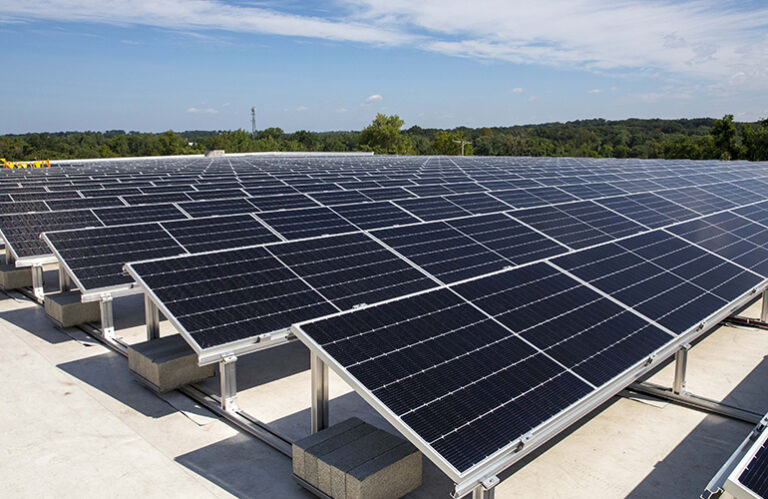Summit Ridge Energy (SRE), an Arlington, Virginia-based commercial solar contractor, will soon complete construction of a 17 MW community solar portfolio of seven projects – or so it is believed by interconnection standards – built on four different rooftops in Maryland.

The 4.8 MW solar project built in the LBA Logistics building on Quad Avenue. Summit Ridge Energy
All four locations are commercial buildings owned by industrial real estate operator LBA Logistics. Work with Black Bear energyan agency that represents institutional real estate owners looking to build renewable energy on-site, LBA started the process of adding solar PV to its buildings in 2019.
“It honestly took them a long time to find an asset where all the pieces of the puzzle lined up,” said Victoria Stulgis, SVP Client Operations at Black Bear Energy. “Everything from the roof era onwards makes sense, but in a good solar market that is not the case [joint venture] Partners or lenders who do not want solar plan to own the property long enough, they have roof rights. That’s one of the reasons I’ve loved working on these solar projects in Maryland. It is rare that you have four assets in one market with one party where you can reach the scale of 17 MW.”
The projects are divided between the cities of Rosedale and Belcamp. The first to be completed was a 4.8 MWDC atop an industrial building on Quad Avenue in Rosedale, where a ribbon was cut in August 2023. Then there is a 2.8 MW in BelcampDC array on Mercedes Drive and 2.3 MWDC and 7.55 MWDC projects on neighboring buildings on Appliance Drive.
Although built as separate units, two of these projects technically have multiple interconnection points. The 4.8 MW array on Quad Avenue and the 7.55 MW project on Appliance Drive have two and three interconnection points, respectively. This is because Maryland’s Community Solar Pilot Program had a rule for community solar projects couldn’t exceed 2MWAC capacity, so SRE has worked around that by planning multiple interconnection points at these locations.
While waiting in interconnection queues is not a quick process, SRE finds working on industrial rooftops faster than on the ground because there are fewer regulatory processes to complete. The company has never worked on a single portfolio of projects as large as LBA’s, but at any given time SRE is building multiple commercial projects. Nate Greenberg, vice president of business development at SRE, admits that it is more expensive to build on roofs, but there is no need to apply for special use permits, conduct wetland surveys or other tests required on projects being found on the ground makes up for this.

Brian Dunn, COO and board member of Summit Ridge Energy, and Perry Schonfeld, president and COO of LBA Realty, at the ribbon cutting of the Quad Avenue project. Summit Ridge Energy
The company uses a standard set of components on every array, including this community solar portfolio. SRE installs Qcells solar panels, SolarEdge inverters and one of two sets of racks depending on roof style, PanelClaw or Opsun.
“I think that’s the biggest thing I’ve learned in the last five or six years of doing this. The actual construction on the roof is the easiest part,” Greenberg said. “It’s the on-site coordination that many developers really think about when they start working on it.”
The Quad Avenue and second Appliance Drive projects have tenants that are active retail suppliers, with product shipments constantly moving in and out of the buildings. The facilities were built during the holidays and SRE had to coordinate its own deliveries, while truckloads of liquor, wine and cosmetics were regularly shipped from the warehouses below.
Untapped community solar potential on industrial properties
In 2022, global investment firm Morgan Stanley published a report on the benefits of installing solar energy on industrial properties titled “Buildings and parking lots: ready to charge?The report claims that commercial properties in the United States alone have the potential to house 328 GWDC of solar energy.
But this segment of the market is still in its infancy, Stulgis said. Black Bear Energy maintains rankings that rank real estate investors based on the amount of solar energy they have installed on site. Once LBA’s 17 MW project portfolio is fully energized, the company will be among the top 20 companies on that list.

Credit: Summit Ridge Energy
There are common barriers to the development of industrial rooftop solar, such as roof rights and the terms of tenant leases, but Stulgis said solar is a means for property owners like LBA to scale solar energy growth. A community solar panel on a commercial roof sells energy back to the utility and the people who subscribe to the project, and not directly to tenants.
“Due to the nature of being on an industrial roof, the solar energy is typically delivered in areas where there is a higher electricity demand and there is much better value for a utility customer as solar energy projects close to the load are generated than when they are generated. in the middle of nowhere and having to pay to transport that electricity and incurring losses across the line,” Stulgis said.
Greenberg said community solar, despite being an underserved market, has opened up commercial rooftop projects. He expects this segment of community solar to continue to grow where these projects can be built. And after five years of development, LBA’s community solar portfolio of four solar sites, consisting of seven different projects, will soon be producing power and contributing to that growth.
“The nice thing about these roof projects is that you build them in the communities we serve. When you look around, you see not only other buildings, but also homes, businesses and restaurants,” Greenberg said. “It’s on an existing roof and we can benefit the people of that community both economically and environmentally. It goes back to why we started Summit Ridge Energy.”


